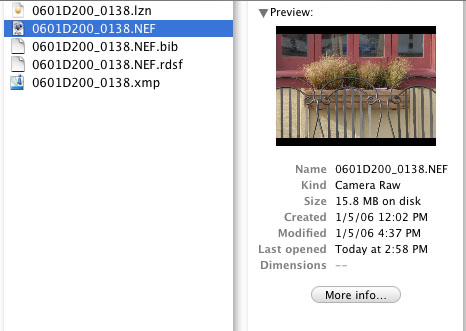The term "non destructive editing" is
currently used in many discussions. It simply means that imaging
tools
leave the original image untouched and only stores instructions
to recreate the final image.
RAW converters work for a long time this way. The challenge
is where to store the instructions.
We mainly look at ACR, Capture One, RawShooter, LightZone, RAW
Developer, Aperture and Lightroom. There are a couple of options used by today's tools:
- Have images and settings data inside a closed database: Aperture
Advantage: Settings and images keep well tied together
Disadvantage: Interfacing with other outside applications
can be hard at times
- Have settings data inside a closed database and pointers
to images outside this database: Lightroom
Advantage: Settings well managed
Disadvantage: Image links can get lost
- Store settings inside the RAW files: Nikon Capture, Canon
DPP
Advantage: Images and settings are one unit
Disadvantage: if all tools do the same we need clear
standards as otherwise other tools might destroy the
information. There also may be locking issues. Any write
to a file can in certain circumstances destroy
the file (image loss). Sometimes other tools cannot read
the modified files (recently Aperture with RAW files
that changed the IPTC information).
- Keep image settings in a system database: ACR (one option),
Capture One, Biible (one option)
Advantage: Local folders get not polluted with settings
files and you can allow editing of offline files
Disadvantage: Hard to move to other machines (Bridge
allows for this purpose an export)
- Keep settings in so called sidecar files: ACR (second option),
Bibble (other option), RawShooter, RAW Developer, LightZone
Advantage: Original RAW file does not get touched
Disadvantage: If you copy images you also need to
copy the settings files. Folders get polluted with
many different settings files.
The last option is the easiest to implement and the most
popular. Here is how it could look like: 
One image and 4 different settings files
The sidecar file system work
fine if you stay with just one single raw converter and hardly
use external image organization tools. But assume you copy
or move files with a third party image organization tool
like Extensis Portfolio, iView Media Pro or Photo Mechanic
then most of these
extra settings files would be lost (means left in the old
place or would not be copied). Some tools like Photo Mechanics
at least recognizes the XMP files.
We will start to lobby the idea
to support also the sidecar files of popular third party RAW
converters and hope to report the first success pretty soon.
What about Aperture and Lightroom?
- If you stay inside the closed world of Aperture all is
fine. But we find that Aperture does not really integrate
well with outside tools (e.g. other RAW converters)
- Ligthroom is
more open but does not right now allow to organize (e.g.
move/copy) the files that the Lightroom library refers to
(this may change). But even then we are not that optimistic
it will have support to recognize third party sidecar files
soon.
Right now "non destructive editing"
is nice to have but no real pleasure if you manage many images.
|